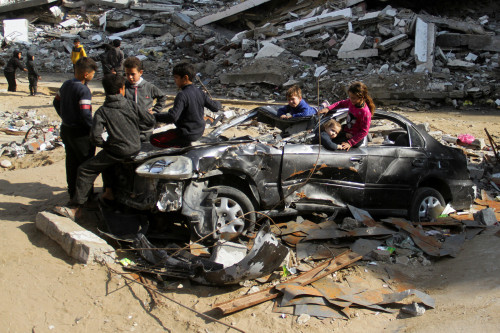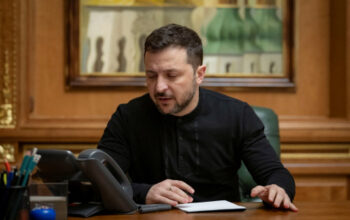(Reuters) -Israel and Hamas agreed to a deal to halt fighting in Gaza and exchange Israeli hostages for Palestinian prisoners, an official briefed on the deal told Reuters on Wednesday, opening the way to a possible end to a devastating 15-month conflict.
Israel and Hamas have been at war in Gaza since gunmen from the Palestinian militant group attacked southern Israel on Oct. 7, 2023, killing 1,200 people and capturing over 250 hostages, according to Israeli tallies.
Israel responded with a military campaign in which more than 46,000 Palestinians have been killed, according to medical officials in the enclave, with thousands more feared buried under the rubble.
Here is a timeline of the war:
Oct. 7, 2023: Hamas-led gunmen storm into southern Israel from Gaza and rampage through communities. Retaliatory airstrikes on Gaza begin, along with a total siege.
Oct. 8 – Lebanon’s Hezbollah fires on Israel, saying its attacks aim to support Palestinians in Gaza, leading to sustained hostilities.
Oct. 13: Israel tells residents of Gaza City, where more than one million people live, to move south, beginning a process that will uproot nearly the entire population of the Gaza Strip.
Oct. 19: A U.S. Navy warship intercepts missiles and drones launched from Yemen towards Israel. Yemen’s Iran-backed Houthis continue attacks on Israel and against Red Sea shipping.
Oct. 21: Aid trucks are allowed through the Rafah border crossing from Egypt into Gaza, where food, water, medicines and fuel are running out. Over coming months, the humanitarian crisis worsens with aid groups and Western governments saying Israel must do more to let in aid.
Oct. 27: Israel launches its ground offensive in Gaza.
Nov. 15: Israeli troops enter Gaza’s biggest hospital, Al Shifa, after a siege of several days. Within a few weeks, all hospitals serving northern Gaza will cease to function.
Nov. 21: Israel and Hamas announce a seven-day truce and release of around half the hostages, but war resumes on Dec. 1.
Dec. 4: Israeli forces launch their first big ground assault in southern Gaza, towards the main southern city, Khan Younis.
From Jan. 1, 2024: Israel signals it will start withdrawing from northern parts of Gaza, but months later it is again fighting militants in the same areas.
Jan. 26: The International Court of Justice (ICJ) in The Hague, also known as the World Court, orders Israel to prevent genocide.
Feb. 29: More than 100 Gazans are killed queuing for aid in the presence of Israeli troops who opened fire, in one of the deadliest incidents of the war.
March 7: Facing political pressure over hunger in Gaza, U.S. President Joe Biden announces work on a floating pier to deliver aid. It will be installed in May but last only until July with supplies remaining very constricted.
April 1: Iran’s embassy compound in Damascus is hit by a suspected Israeli airstrike that kills several military officers including a top general. Tehran responds two weeks later by firing hundreds of missiles and drones at Israel.
May 6 – Hamas says it has accepted a proposal for a ceasefire, but Israel said it had not agreed to that text.
Israel tells Palestinians to evacuate parts of Rafah after its forces take control of a buffer zone along the border between Gaza and Egypt, giving Israel effective authority over the Palestinian territory’s entire land border.
June 23 – Netanyahu says the phase of intense fighting against Hamas in Gaza is coming to an end but that the war will not finish until Hamas no longer controls the enclave. However, heavy bouts of fighting continue across Gaza for months more.
June 25 – The Global hunger monitor, the IPC, says Gaza remains at high risk of famine.
July 2 – Israel announces new evacuation orders for the southern cities of Khan Younis and Rafah, which the United Nations called the largest edict of its kind since the beginning of the war.
July 27 – A Hezbollah rocket kills a group of 12 children and teenagers in the Israeli-occupied Golan Heights, prompting Israel to vow retaliation.
Aug. 1 – Israel’s military says it killed Mohammed Deif, Hamas’ military chief, in an airstrike on July 13. Hamas neither confirmed nor denied Deif’s death. Palestinian officials said the strike killed 90 people.
Aug. 23 – World Health Organization says a first confirmed case of type 2 polio in Gaza for 25 years has paralysed a baby.
Sept. 17 – Israel detonates thousands of booby-trapped pager communications devices used by Hezbollah in Lebanon, injuring hundreds of its members.
Sept. 28 – An Israeli airstrike in Beirut kills Hezbollah leader Hassan Nasrallah, one of many strikes against the group’s senior leadership.
Oct. 5 – Israeli forces launch major anti-Hamas operation in northern Gaza focused on Jabalia refugee camp near Gaza City and Beit Hanoun and Beit Lahiya towns. The push continues into 2025. Much of the surrounding area is cleared of people and razed.
Oct. 16 – Israel kills Hamas leader Yahya Sinwar in a shootout in Rafah.
Nov. 21 – International Criminal Court issues arrest warrants for Netanyahu, former defence chief Yoav Gallant, and Hamas’ Ibrahim Al-Masri — also known as Mohammed Deif — for alleged war crimes and crimes against humanity in the Gaza war.
Nov. 27 – Israel and Hezbollah agree a ceasefire in Lebanon. On the same day rebels in Syria launch an offensive that will quickly topple President Bashar al-Assad, a major ally of Hezbollah and its Iranian backer.
Dec. 2 – U.S. President-elect Donald Trump says there will be “hell to pay” in the Middle East if hostages in Gaza are not freed before his Jan. 20 inauguration. Using similar language, he reiterates the demand on Dec. 16 and Jan. 7.
Jan. 15 – Negotiators reach a deal for a ceasefire in the Gaza war between Israel and Hamas, an official briefed on the negotiations told Reuters, after 15 months of conflict that has killed tens of thousands of Palestinians and inflamed the Middle East.
(Compiled by Peter Graff and Angus McDowall, Editing by William Maclean)





